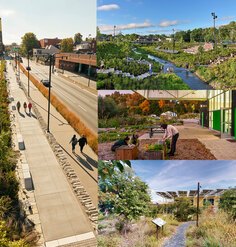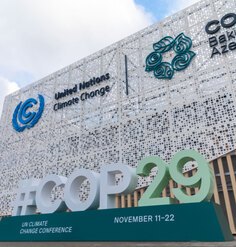From the Field: Exploring the Benefits of Ecologically-Based River Management
By Shanna Atherton, MLA-EP candidate, University of California, Berkeley
Restoring natural processes to degraded or heavily managed river systems while respecting human needs is no easy feat, but this summer the Case Study Investigation (CSI) program gave our research team the opportunity to look at three projects that have done just that. Ranging in scope from 35 to 1,011 acres, the restoration projects along Tassajara Creek, the Colorado River, and the Napa River clearly illustrate that through collaboration and a willingness to think outside the box, ecological function can be promoted without sacrificing flood control needs or water rights, and that impressive social, economic, and environmental benefits can be realized along the way.
Tassajara Creek Restoration Project
Located in the heart of the Livermore Valley east of San Francisco Bay, this 35-acre creek restoration project was designed to halt channel incision and manage flooding in the newly developed area of eastern Dublin. The project was conceived as an alternative to the traditional trapezoidal flood control channels prolific in the valley, an alternative that promotes habitat diversity and natural geomorphic processes within the riparian corridor while maintaining its flood management capabilities, increasing the aesthetic value of the channel and serving as an amenity to nearby residents. Our research team set out to quantify the social and economic benefits that such an alternative could provide to local residents and the district charged with maintaining the site. We observed public use of the project’s features over a weekend in the summer, including a local trail that extends the regional trail network and a low-flow crossing that provides access to a regional park. We also analyzed property values in communities adjacent to the creek, comparing these values to communities near a trapezoidal flood control channel, and we worked with the local flood control district to estimate the lowered long-term maintenance costs of the restored channel compared to those of a trapezoidal channel.
Yuma East Wetlands Restoration
Located near the historic downtown area of Yuma, Arizona along 350 acres of the lower Colorado River, the Yuma East Wetland project transformed a degraded wetland — once a site of illegal dumping and transient encampments — into a refuge for many threatened and endangered species. Recreational amenities provide much needed access for locals to the river, while an innovative water reuse plan minimizes the need to draw on tightly guarded water rights. This project is a hallmark of what can be achieved when divergent constituents of a community band together to re-envision public open space.
Napa River Flood Control Project
The Napa River Flood Control Project was part of a monumental effort in the 1990s to reconceive the river’s flood control strategy on a regional scale. Adhering to the ‘living river’ principles developed by an impressive community coalition, the city of Napa has implemented project phases along a 7-mile stretch of river, resulting in the restoration of 1,011 acres of habitat that meet the primary project aim of protecting the functionality of the river’s ecological systems while providing flood protection for many Napa residents. Though the project’s goal of 100-year flood protection will not be met until the final phases of the project have been completed, many environmental, economic, and social benefits are already being realized by the community today. We set out to identify these benefits, reviewing vegetation and bird monitoring efforts of the completed project phases as well as employment data that illustrates the direct impact of this project on the local workforce.
Working on these projects has provided our team members with valuable insights into the many benefits that the restoration of ecological function, guided by design principles, can have on watercourses, the agencies that manage them, and the communities that border them. We hope that through our identification and exploration of these benefits, others will be inspired to explore creative solutions to complex design challenges.
Research Fellow G. Mathias Kondolf and student Research Assistants Zan Rubin and Shanna Atherton are participating in LAF’s 2013 Case Study Investigation (CSI) program and working to document the social, environmental and economic benefits of three exemplary landscape projects in California and Arizona. Any opinions expressed in this article belong solely to the author. Their inclusion in this article does not reflect endorsement by LAF.











